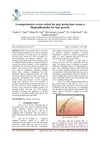
Search
forProducts matching "dandruff"
Tracking 9 products like 375 Nizoral Anti-Dandruff Shampoo with 1% Ketoconazole, Fresh Scent, 7 Fl Oz, 377 Jason Dandruff Relief Treatment Shampoo, 12 Oz, 380 Head & Shoulders Clinical Strength Dandruff Shampoo, 27 Dandruff Detox Shampoo and 33 Ketoconazole Shampoo from by companies like Amazon, Hims and Keeps. View all 9 products »
Sort by
Research
420-450 / 919 results

research Bureau of Legal Medicine and Legislation
Companies agreed to stop false advertising about their products' health benefits.

research Bureau of Investigation: Agreements by Promoters of Patent Medicines, Medical Devices, and Cosmetics Following FTC Actions (1944-1945)
Companies agreed to stop making false health claims about their products.

research A Newer Approach in the Treatment of Seborrheic Dermatitis With QR678 and QR678 Neo: A Prospective Pilot Study
QR678 Neo® improved seborrheic dermatitis symptoms in a small group of patients.

research Platelet-Rich Plasma Associated with Hair Transplants for the Treatment of Androgenetic Alopecia Showed No Benefits
No benefits found using platelet-rich plasma in hair transplants for male hair loss.
research Traditional Chinese Medicine Treatment for Androgenetic Alopecia Based on Animal Experiments: A Systematic Review and Meta-Analysis
Traditional Chinese Medicine may help treat hair loss but needs more research.

research A Review of the Formulation of Herbal Shampoo Compared to Allopathic Shampoo
Herbal shampoos are safer and effective for hair care compared to chemical shampoos.

research Hair Care Cosmetics: Functions and Ingredients of Shampoos, Rinses, and Hair Growth Promoters
The document explains how shampoos clean, rinses condition, one-step shampoos offer convenience, and hair growth promoters aim to prevent hair loss, emphasizing the importance of scientific evidence for their effectiveness.

research Madam C.J. Walker and Her Wonderful Hair Grower
Madam C.J. Walker became the first self-made female millionaire in the USA by creating a successful hair care product for Black women.

research Comparative Study on the Effect of Drying Methods on the Plant Punica Granatum Using Shade, Solar, and Convective Drying in the Southwest of Algeria
Solar drying is the best method for drying pomegranate peels quickly and efficiently.

research Formulation and Characterization of Novel Ziziphus Spina-Christi Herbal Preparation as a Hair Tonic
The new herbal shampoo is effective, safe, and more affordable than other products.

research Molecular Docking Studies and ADME-Tox Prediction of Phytocompounds from Merremia Peltata as a Potential Anti-Alopecia Treatment
The compound 16 from the Merremia peltata plant could potentially be a good treatment for hair loss (alopecia) due to its strong activity and favorable skin absorption.

research Molecular Docking Studies and ADME-Tox Prediction of Phytocompounds from Punica Granatum Peel as a Potential Anti-Alopecia Treatment
Pomegranate peel compounds may help treat hair loss.

research Management of Indralupta (Alopecia Areata) by Jaluka Avacharana and Shamana Aoushadhi: A Case Report
Ayurvedic treatments can effectively regrow hair in alopecia areata.

research A Comprehensive Review Article for Poly Herbal Hair Serum: Magical Remedies for Hair Growth
MagicalRemedies serum effectively promotes healthy hair growth and reduces damage.

research Melandrium Firmum Extract Promotes Hair Growth by Modulating 5α-Reductase Activity and Gene Expression in C57BL/6J Mice
Melandrium firmum extract helps mice grow hair by blocking a hair loss enzyme and changing hair growth genes.

research Sensitive Scalp: Does This Condition Exist? An Epidemiological Study
Nearly half of the French individuals surveyed reported having a sensitive scalp, more common in women, often linked to hair loss and symptoms like itching, and triggered by factors including shampoos and pollution.

research Formulation and Evaluation of Herbal Hair Dye Compared to Marketed Formulation
The herbal hair dye with a 1:2 henna to indigo ratio works well, is safe, and eco-friendly.

research Androgenetic Alopecia: A Review and Emerging Treatments
Hair loss, known as Androgenetic Alopecia, is often caused by hormones and can be diagnosed using noninvasive techniques. Treatments include topical minoxidil and oral finasteride, with new treatments being explored. There may also be a link between this type of hair loss and heart disease risk.

research Proceedings of the Ninth World Congress for Hair Research 2015
The 2015 Hair Research Congress concluded that stem cells, maraviroc, and simvastatin could potentially treat Alopecia Areata, topical minoxidil, finasteride, and steroids could treat Frontal Fibrosing Alopecia, and PTGDR2 antagonists could also treat alopecia. They also found that low-level light therapy could help with hair loss, a robotic device could assist in hair extraction, and nutrition could aid hair growth. They suggested that Alopecia Areata is an inflammatory disorder, not a single disease, indicating a need for personalized treatments.

research The Hair Tales of Women of Color in Northern Manhattan: A Qualitative Analysis
Women of color in Northern Manhattan view hair care as important to their identity and culture, and education on harmful chemicals in hair products is needed.

research Australasian Society for Dermatology Research Meeting, May 2006
The meeting highlighted the genetic basis of female pattern hair loss and various skin health insights.

research Herbal Hair Gel Formulation with 5α-Reductase Inhibitory Activity and Standardization by HPTLC
The herbal hair gel could be a safe hair growth treatment with minimal side effects.

research Ethnopharmacological Significance of Eclipta Alba (L.) Hassk. (Asteraceae)
Eclipta alba has many health benefits and contains compounds with potential for drug development.

research Differential Diagnosis of Hair Loss in Children
The document concludes that early diagnosis and treatment are crucial for children with hair loss to prevent permanent damage, although not all conditions can be effectively treated.

research In Vivo Hair Growth-Promoting Efficacies of Herbal Extracts and Their Cubosomal Suspensions
Some herbal extracts, especially when used in cubosomal suspensions, were as effective as Minoxidil in promoting hair growth.

research Hormonal Contraceptives: Pharmacology Tailored to Women's Health
New hormonal contraceptives are safer, have fewer side effects, and offer health benefits for women.

research Potentiality of Hair Growth Promoting Activity of Aqueous Extract of Abrus Precatorius Linn. on Wistar Albino Rats
The Abrus precatorius extract can effectively promote hair growth similar to standard treatments.

research A Primer on Cosmetics for Dermatologists
Dermatologists need to know about cosmetics to help patients with skin issues and recommend safe products.

research Optimal Management of Plaque Psoriasis in Adolescents: Current Perspectives
The document concludes that proper treatment and management of plaque psoriasis in adolescents can improve their quality of life.